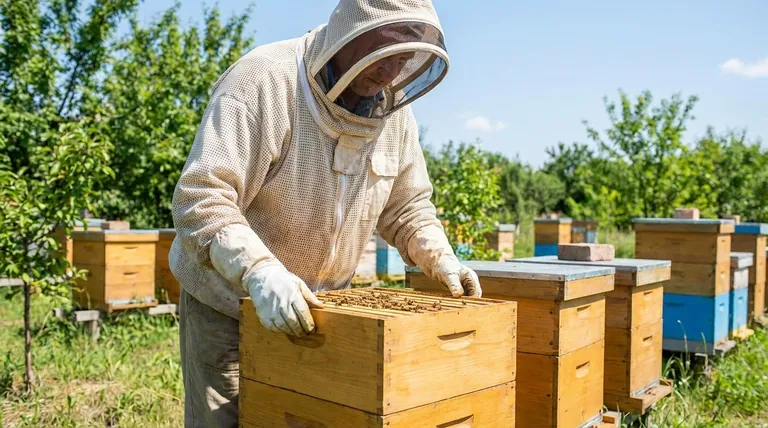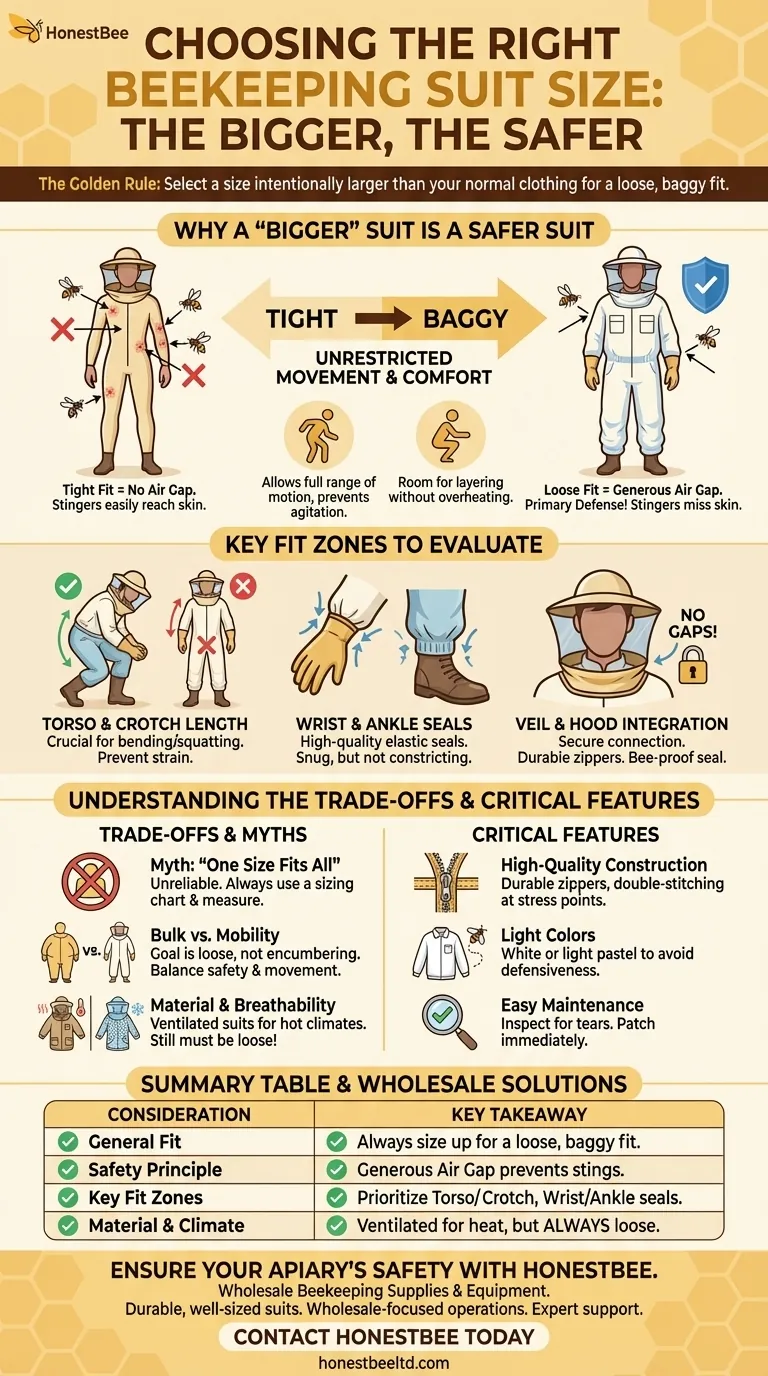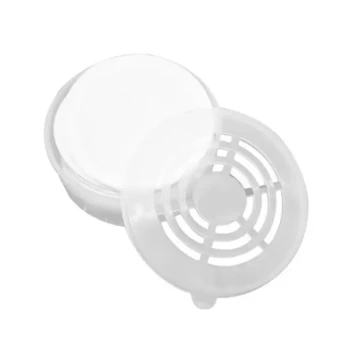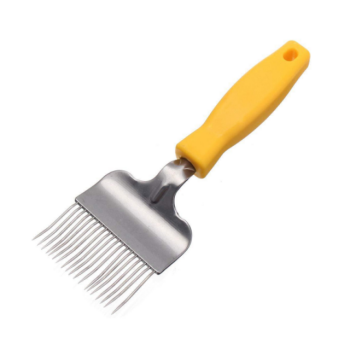When choosing a beekeeping suit, the most critical rule is to select a size that is intentionally larger than your normal clothing. You will wear the suit over your regular clothes, and a loose, baggy fit is not just for comfort—it is a fundamental aspect of your protection against stings.
Your goal is not to find a suit that fits like clothing, but one that creates a generous air gap between the fabric and your skin. This space is your primary defense, as it prevents a bee's stinger from reaching you even if it penetrates the material.

Why a "Bigger" Suit is a Safer Suit
A common mistake for new beekeepers is buying a suit that fits snugly. Understanding the principles behind proper sizing is key to staying safe and comfortable.
The Principle of the Air Gap
A bee’s stinger has a finite length. When your suit is loose, a bee that lands on you and attempts to sting will most often inject its venom into the empty space between the fabric and your body.
A tight suit, by contrast, holds the fabric directly against your skin. This effectively negates the suit's protection, turning it into a simple cloth barrier that a stinger can easily pass through.
Unrestricted Movement is Key
Working with bees requires calm, deliberate movements. A suit that is too tight in the shoulders, crotch, or knees will restrict your motion.
This forces you into awkward positions, which can lead to sudden, jerky movements that agitate the bees. A baggy suit allows for a full range of motion, enabling you to bend, lift, and work smoothly.
Layering for Comfort
You will be wearing your own clothes underneath the suit. Sizing up ensures you have enough room for a shirt and pants without feeling compressed or overheated. This space also contributes to better airflow within the suit.
Key Fit Zones to Evaluate
"Sizing up" is a general rule, but you must pay attention to specific areas to ensure a truly effective and secure fit.
Torso and Crotch Length
This is the most common point of failure in suit sizing. A suit with an insufficient torso length will pull tightly when you bend over, creating strain and compromising safety.
Ensure you can squat and bend comfortably without the suit pulling at the shoulders or crotch. This is non-negotiable for practical beekeeping.
Wrist and Ankle Seals
The openings of your suit are potential entry points for bees. High-quality elastic seals at the wrists and ankles are essential.
The elastic should be snug enough to create a complete seal over your gloves and boots but not so tight that it cuts off circulation.
Veil and Hood Integration
Whether you choose a suit with an integrated hood or a separate veil, the connection point around your neck is critical. There must be no gaps.
Ensure the zippers are durable and create a complete, bee-proof seal. You should also have an excellent range of vision without the veil mesh touching your face.
Understanding the Trade-offs
Choosing the perfect suit involves balancing competing factors. Being aware of them helps you make an informed decision.
The Myth of "One Size Fits All"
Be wary of one-size-fits-all claims. Human bodies vary too much for this to be a reliable sizing method. Always look for a manufacturer's sizing chart and measure yourself.
Bulk vs. Mobility
While a baggy suit is safer, an excessively large suit can become clumsy. The extra fabric can snag on equipment or branches. The goal is a loose fit, not an encumbering one.
Material and Breathability
A thick, heavy cotton suit provides excellent protection but can be incredibly hot. A modern aerated or ventilated suit uses mesh layers to improve airflow.
Ventilated suits can feel slightly bulkier, but their comfort in warm climates is a significant advantage. The sizing principle remains the same—always ensure it is loose.
Critical Features That Complement a Good Fit
A perfect fit is only part of the equation. Look for these features to ensure your suit is truly effective.
High-Quality Construction
Inspect the zippers and stitching. Strong, durable zippers that are easy to use with gloves on are a mark of quality. Double-stitching at stress points ensures the suit will last.
Light Colors
Bees are known to react more defensively to dark colors, which they may perceive as a natural predator (like a bear). For this reason, beekeeping suits are almost always white or a light pastel.
Easy Maintenance
Before every visit to the hive, inspect your suit for any holes or tears. A small hole is an open invitation for a bee. Ensure the material is durable and can be easily patched if necessary.
Making the Right Choice for Your Goal
Your final decision should be based on your specific climate and priorities.
- If your primary focus is maximum safety: Choose a full-cut suit at least one size larger than your street clothes and prioritize models with heavy-duty zippers and robust elastic seals.
- If your primary focus is comfort in a hot climate: Invest in a multi-layer ventilated suit, ensuring you still size up to maintain the protective air gap.
- If your primary focus is mobility and frequent work: Pay special attention to the torso length, ensuring you can bend and squat without any restriction.
A properly sized bee suit is an investment in your safety, confidence, and enjoyment of beekeeping.
Summary Table:
| Consideration | Key Takeaway |
|---|---|
| General Fit | Always choose a size larger than your normal clothes for a loose, baggy fit. |
| Safety Principle | A generous air gap between fabric and skin prevents stings from reaching you. |
| Key Fit Zones | Prioritize comfortable torso/crotch length and snug elastic seals at wrists/ankles. |
| Material & Climate | Choose ventilated suits for hot climates, but always maintain the loose fit principle. |
Ensure Your Apiary's Safety and Efficiency with the Right Gear
Equip your commercial beekeeping operation or distribution business with suits that guarantee protection and comfort. At HONESTBEE, we supply wholesale beekeeping supplies and equipment designed for the demands of professional apiaries and distributors.
We provide:
- Durable, well-sized suits that adhere to the critical safety principles outlined above.
- Wholesale-focused operations to efficiently outfit your entire team or inventory.
- Expert support for selecting the right equipment to enhance safety and productivity.
Ready to outfit your team with superior protection? Contact HONESTBEE today to discuss your wholesale supply needs and ensure every beekeeper is properly equipped.
Visual Guide

Related Products
- Wholesales Dadant Size Wooden Bee Hives for Beekeeping
- Yellow Plastic Bucket Pail Perch for Beekeeping
- Long Langstroth Style Horizontal Top Bar Hive for Wholesale
- Professional Insulated Plastic Bee Hives
- Professional Insulated Winter Hive Wrap for Beekeeping
People Also Ask
- What are the essential pieces of equipment for most beekeepers? Get Started with the Right Gear
- What is beekeeping equipment? Essential Tools for Commercial Apiaries & Distributors
- What should you do if you find an ant nest near your beehive? Essential Strategies for Hive Protection
- What are the characteristics of oil-based paint for beehives? Durability vs. Modern Practicality
- What types of products are available for beekeeping needs? Essential Equipment for Apiaries & Distributors



















